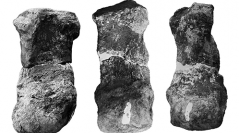

 Comptes Rendus Palevol
4 (3) - Pages 225-234
Comptes Rendus Palevol
4 (3) - Pages 225-234Seven articulated bones of a left foot, comprising the talus, incomplete calcaneum, cuboid, co-ossified navicular + ectocuneiform, the mesocuneiform, metatarsals II, III and IV, as well as an isolated lower molar, were discovered at Cheboit, Baringo District, Kenya. All these remains came from the Kapgoywa Member (5.9 to 6.1 Ma) at the base of the Lukeino Formation. They belong to a new species of Ancylotherium, A. cheboitense nov. sp. This Schizotheriinae is characterised by its remarkably stocky skeleton, its high and wide talus, its massive metatarsals, in particular the fourth, of which the anterior surface of the diaphysis is strongly depressed. A. cheboitense is smaller but much more massive than Ancylotherium hennigi and even more so than Chemositia tugenensis, both species that have (at least partly) about the same age. It could represent an attempt to adapt to a humid habitat.
Perissodactyla, Chalicotheriidae, Schizotheriinae, Ancylotherium, New, Upper Miocene, Kenya